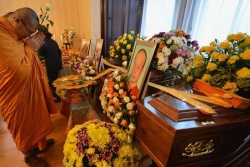Buddhist Funeral Rituals Continue for a Full Week
The pain of personal grief is no less for a Buddhist than it is for anybody else. The rituals that surround death in Buddhist countries reflect beliefs. When a person dies, the body is bathed and dressed in the finest of clothes, and a coin (gadaw ga) is placed in the mouth to pay the “toll” for crossing into the next life. A Buddhist monk will be called upon to perform chanting and prayers.
For three to five days, family members will keep a vigil at the deceased’s bedside; guests visit to pay their respects and will often be offered refreshments of tea and black melon seeds. All doors and windows of the house will be left open for seven days to allow the deceased’s spirit to leave.
When the wake is over, a funeral takes place. These days cremation is the usual type of funeral, though burial is still quite common. Mourners—who wear dark clothes—are given Buddhist scriptures containing lessons on the impermanence of life, along with paper fans bearing the name of the deceased.
Monks perform a recitation. Depending on its financial situation, the family is either given gifts of floral wreaths or money. In rural areas, they’re likely to be offered food and practical help.
Seven days after the death, monks are offered a meal in return for a recitation of blessings that protect the dead person’s soul as it progresses. The funeral process is concluded with a water libation ceremony.
According to superstition, it is bad luck for women to wash their hair soon after a funeral.
